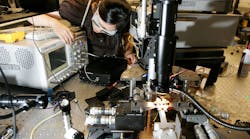\r\n\r\nThe event challenges teams to design, build, and race unique, ultra-fuel-efficiency autos against competitors from around the world. \r\n\r\nThe prize for the best design goes to the team that travels the farthest on 1 liter (about \u00bc gallon)of fuel. \r\n\r\nFor their entry into this year's competition, team Iron Warriors turned to 3D printing to help lighten the load of their critical hardware at the heart of the design. \r\n\r\n\"[The 3D printed gear, which is part of [the] propulsion transmission is both durable and three-times lighter than if we did it with aluminum,\" the team said in a statement. \"To reduce mass, we have 3-D printed parts for carrying heavy loads, and then cover[ed] them with carbon fiber.\"\r\n\r\n\"The effect,\" they added, \"was fantastic.\"\r\n\r\n\"Fantastic\" doesn't do it justice. \r\n\r\nShifting these critical components to lightweight additive structures - built on a sub-$2,000 Zortrax industrial printer, no less - helped the team achieve an astonishing 640 km/l result. That translates to more than 1,505 m/g. Zortrax industrial printer\r\n\r\nAnd if that's not disruptive or revolutionary, I don't know what is.\r\n\r\n"}" data-sheets-userformat="{"2":15165,"3":{"1":0},"5":{"1":[{"1":2,"2":0,"5":{"1":2,"2":0}},{"1":0,"2":0,"3":1},{"1":1,"2":0,"4":1}]},"6":{"1":[{"1":2,"2":0,"5":{"1":2,"2":0}},{"1":0,"2":0,"3":1},{"1":1,"2":0,"4":1}]},"7":{"1":[{"1":2,"2":0,"5":{"1":2,"2":0}},{"1":0,"2":0,"3":1},{"1":1,"2":0,"4":1}]},"8":{"1":[{"1":2,"2":0,"5":{"1":2,"2":0}},{"1":0,"2":0,"3":1},{"1":1,"2":0,"4":1}]},"11":3,"12":0,"14":{"1":2,"2":0},"15":"Arial","16":10}">It's easy to get carried away with 3D printing. The moment we start talking about additive or some new application of it, we all seem to fall into the usual lingo of 'disruption' and 'revolutionary.' I generally try to avoid that path - and generally fail in the attempt. And it looks like this is one of those cases. A team of student engineers and racers out of Poland - dubbed the "Iron Warriors" - recently competed in the Shell Eco-Marathon Europe challenge in Rotterdam. The event challenges teams to design, build, and race unique, ultra-fuel-efficiency autos against competitors from around the world. The prize for the best design goes to the team that travels the farthest on 1 liter (about ¼ gallon)of fuel. For their entry into this year's competition, team Iron Warriors turned to 3D printing to help lighten the load of their critical hardware at the heart of the design. "[The 3D printed gear, which is part of [the] propulsion transmission is both durable and three-times lighter than if we did it with aluminum," the team said in a statement. "To reduce mass, we have 3-D printed parts for carrying heavy loads, and then cover[ed] them with carbon fiber." "The effect," they added, "was fantastic." "Fantastic" doesn't do it justice. Shifting these critical components to lightweight additive structures - built on a sub-$2,000 Zortrax industrial printer, no less - helped the team achieve an astonishing 640 km/l result. That translates to more than 1,505 m/g. And if that's not disruptive or revolutionary, I don't know what is.











